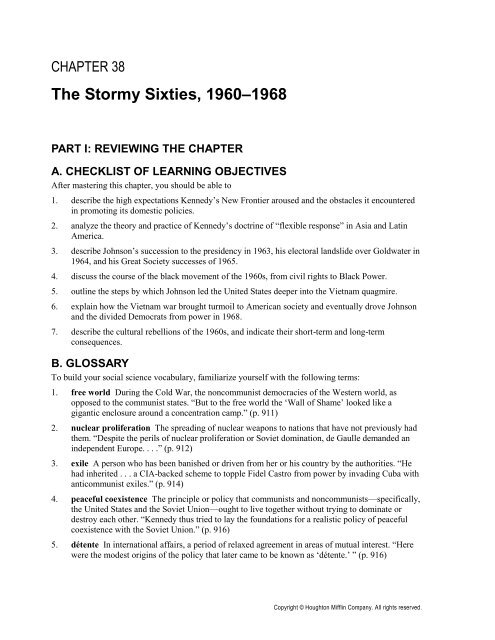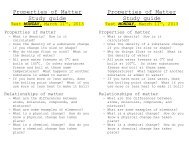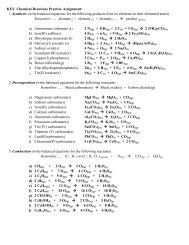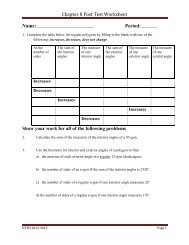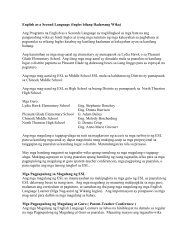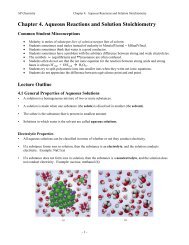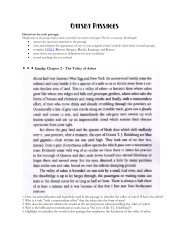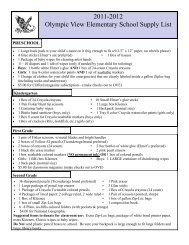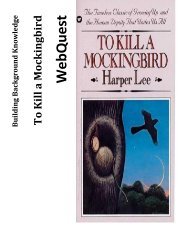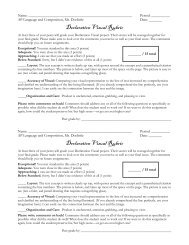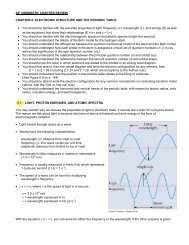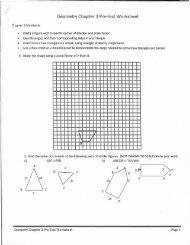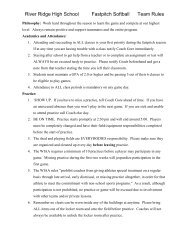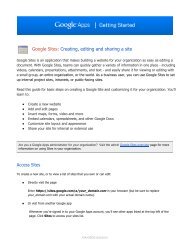The Stormy Sixties, 1960
The Stormy Sixties, 1960
The Stormy Sixties, 1960
Create successful ePaper yourself
Turn your PDF publications into a flip-book with our unique Google optimized e-Paper software.
CHAPTER 38<br />
<strong>The</strong> <strong>Stormy</strong> <strong>Sixties</strong>, <strong>1960</strong>–1968<br />
PART I: REVIEWING THE CHAPTER<br />
A. CHECKLIST OF LEARNING OBJECTIVES<br />
After mastering this chapter, you should be able to<br />
1. describe the high expectations Kennedy‘s New Frontier aroused and the obstacles it encountered<br />
in promoting its domestic policies.<br />
2. analyze the theory and practice of Kennedy‘s doctrine of ―flexible response‖ in Asia and Latin<br />
America.<br />
3. describe Johnson‘s succession to the presidency in 1963, his electoral landslide over Goldwater in<br />
1964, and his Great Society successes of 1965.<br />
4. discuss the course of the black movement of the <strong>1960</strong>s, from civil rights to Black Power.<br />
5. outline the steps by which Johnson led the United States deeper into the Vietnam quagmire.<br />
6. explain how the Vietnam war brought turmoil to American society and eventually drove Johnson<br />
and the divided Democrats from power in 1968.<br />
7. describe the cultural rebellions of the <strong>1960</strong>s, and indicate their short-term and long-term<br />
consequences.<br />
B. GLOSSARY<br />
To build your social science vocabulary, familiarize yourself with the following terms:<br />
1. free world During the Cold War, the noncommunist democracies of the Western world, as<br />
opposed to the communist states. ―But to the free world the ‗Wall of Shame‘ looked like a<br />
gigantic enclosure around a concentration camp.‖ (p. 911)<br />
2. nuclear proliferation <strong>The</strong> spreading of nuclear weapons to nations that have not previously had<br />
them. ―Despite the perils of nuclear proliferation or Soviet domination, de Gaulle demanded an<br />
independent Europe. . . .‖ (p. 912)<br />
3. exile A person who has been banished or driven from her or his country by the authorities. ―He<br />
had inherited . . . a CIA-backed scheme to topple Fidel Castro from power by invading Cuba with<br />
anticommunist exiles.‖ (p. 914)<br />
4. peaceful coexistence <strong>The</strong> principle or policy that communists and noncommunists—specifically,<br />
the United States and the Soviet Union—ought to live together without trying to dominate or<br />
destroy each other. ―Kennedy thus tried to lay the foundations for a realistic policy of peaceful<br />
coexistence with the Soviet Union.‖ (p. 916)<br />
5. détente In international affairs, a period of relaxed agreement in areas of mutual interest. ―Here<br />
were the modest origins of the policy that later came to be known as ‗détente.‘ ‖ (p. 916)<br />
Copyright © Houghton Mifflin Company. All rights reserved.
Chapter 38: <strong>The</strong> <strong>Stormy</strong> <strong>Sixties</strong>, <strong>1960</strong>–1968 343<br />
6. sit-in A demonstration in which people occupy a facility for a sustained period to achieve<br />
political or economic goals. ―Following the wave of sit-ins that surged across the South. . . .‖ (p.<br />
916)<br />
7. establishment <strong>The</strong> ruling inner circle of a nation and its principal institutions. ―Goldwater‘s<br />
forces had . . . rid[den] roughshod over the moderate Republican ‗eastern establishment.‘‖ (p. 921)<br />
8. literacy test A literacy examination that a person must pass before being allowed to vote.<br />
―Ballot-denying devices like the poll tax, literacy tests, and barefaced discrimination still barred<br />
black people from the political process.‖ (p. 924)<br />
9. ghetto <strong>The</strong> district of a city where members of a religious or racial minority are forced to live,<br />
either by legal restriction or by informal social pressure. (Originally, ghettoes were enclosed<br />
Jewish districts in Europe.) ―. . . a bloody riot exploded in Watts, a black ghetto in Los Angeles.‖<br />
(p. 925)<br />
10. black separatism <strong>The</strong> doctrine that blacks in the United States ought to separate themselves from<br />
whites, either in separate institutions or in a separate political territory. ―. . . Malcolm X trumpeted<br />
black separatism. . . .‖ (p. 925)<br />
11. hawk During the Vietnam War, someone who favored vigorous prosecution or escalation of the<br />
conflict. ―If the United States were to cut and run from Vietnam, claimed prowar ‗hawks,‘ other<br />
nations would doubt America‘s word. . . .‖ (p. 930)<br />
12. dove During the Vietnam War, someone who opposed the war and favored de-escalation or<br />
withdrawal by the United States. ―New flocks of antiwar ‗doves‘ were hatching daily.‖ (p. 929)<br />
13. militant In politics, someone who pursues political goals in a belligerent way, often using<br />
paramilitary means. ―Other militants . . . shouted obscenities. . . .‖ (p. 931)<br />
14. dissident Someone who dissents, especially from an established or normative institution or<br />
position. ―. . . Spiro T. Agnew [was] noted for his tough stands against dissidents and black<br />
militants.‖ (p. 931)<br />
15. coattails In politics, the ability of a popular candidate at the top of a ticket to transfer some of his<br />
or her support to lesser candidates on the same ticket. ―Nixon was . . . the first president-elect<br />
since 1848 not to bring in on his coattails at least one house of Congress. . . .‖ (p. 932)<br />
PART II: CHECKING YOUR PROGRESS<br />
A. True-False<br />
Where the statement is true, circle T; where it is false, circle F.<br />
1. T F Kennedy‘s attempt to control rising steel prices met strong opposition from big<br />
business.<br />
2. T F <strong>The</strong> Kennedy doctrine of ―flexible response‖ was applied primarily to conflicts with<br />
Soviet communism in Europe.<br />
3. T F <strong>The</strong> U.S.-supported coup against the corrupt Diem regime brought South Vietnam<br />
greater democracy and political stability.<br />
4. T F Kennedy financed and trained the Cuban rebels involved in the Bay of Pigs invasion<br />
but refused to intervene directly with American troops or planes.<br />
5. T F <strong>The</strong> Cuban missile crisis ended in a humiliating defeat for Khrushchev and the Soviet<br />
Union.<br />
Copyright © Houghton Mifflin Company. All rights reserved.
344 Chapter 38: <strong>The</strong> <strong>Stormy</strong> <strong>Sixties</strong>, <strong>1960</strong>–1968<br />
6. T F Kennedy encouraged the civil rights movement to become more outspoken in its<br />
opposition to segregation and discrimination.<br />
7. T F Johnson‘s landslide victory came in every part of the country except the traditionally<br />
Republican Midwest.<br />
8. T F <strong>The</strong> Gulf of Tonkin Resolution authorized the president to respond to naval attacks but<br />
kept the power to make war in Vietnam firmly in the hands of Congress.<br />
9. T F Johnson‘s Great Society programs attempted to balance the federal budget and return<br />
power to the states.<br />
10. T F <strong>The</strong> nonviolent civil rights movement, led by Martin Luther King, Jr., achieved great<br />
victories in integration and voting rights for blacks in 1964 and 1965.<br />
11. T F <strong>The</strong> urban riots of the late <strong>1960</strong>s demonstrated that the South had not been improved by<br />
the civil rights movement.<br />
12. T F <strong>The</strong> campaigns of Senators McCarthy and Kennedy forced Johnson to withdraw as a<br />
presidential candidate and promoted de-escalation of the Vietnam War.<br />
13. T F <strong>The</strong> deep Democratic divisions over Vietnam helped elect Nixon as president in 1968.<br />
14. T F One major American institution largely unaffected by the cultural upheaval of the<br />
<strong>1960</strong>s was the Roman Catholic Church.<br />
15. T F <strong>The</strong> ―sexual revolution‖ of the <strong>1960</strong>s included the introduction of the birth control pill<br />
and the increasing visibility of gays and lesbians.<br />
B. Multiple Choice<br />
Select the best answer and circle the corresponding letter.<br />
1. President Kennedy‘s New Frontier proposals for increased federal educational aid and medical<br />
assistance to the elderly<br />
a. succeeded because of his skill in legislative bargaining.<br />
b. were traded away in exchange for passage of the bill establishing the Peace Corps.<br />
c. were stalled by strong opposition in Congress.<br />
d. were strongly opposed by business interests.<br />
2. <strong>The</strong> industry that engaged in a bitter conflict with President Kennedy over price increases was<br />
a. the airline industry.<br />
b. the health care industry.<br />
c. the steel industry.<br />
d. the oil industry.<br />
3. <strong>The</strong> fundamental military policy of the Kennedy administration was to<br />
a. develop a ―flexible response‖ to fighting ―brushfire wars‖ in the Third World.<br />
b. threaten massive nuclear retaliation against any communist advances.<br />
c. build up heavy conventional armed forces in Western Europe against the threat of a Soviet<br />
invasion.<br />
d. provide military assistance to client states in the Third World so that they could fight proxy<br />
wars without the need of American forces.<br />
4. <strong>The</strong> first major foreign-policy disaster of the Kennedy administration came when<br />
a. Middle East governments sharply raised the price of imported oil.<br />
b. American-backed Cuban rebels were defeated by Castro‘s Cuban army at the Bay of Pigs.<br />
c. Khrushchev forced American missiles out of Turkey during the Cuban missile crisis.<br />
Copyright © Houghton Mifflin Company. All rights reserved.
Chapter 38: <strong>The</strong> <strong>Stormy</strong> <strong>Sixties</strong>, <strong>1960</strong>–1968 345<br />
d. American Green Beret guerilla forces began suffering heavy casualties in the jungles of<br />
Vietnam.<br />
5. <strong>The</strong> Cuban missile crisis ended when<br />
a. the American-backed Cuban invaders were defeated at the Bay of Pigs.<br />
b. the United States agreed to allow Soviet missiles in Cuba as long as they were not armed<br />
with nuclear weapons.<br />
c. the Soviets agreed to pull all missiles out of Cuba and the United States agreed not to invade<br />
Cuba.<br />
d. <strong>The</strong> United States and the Soviet Union agreed that Cuba should become neutral in the Cold<br />
War.<br />
6. <strong>The</strong> Kennedy administration was pushed into a stronger stand on civil rights by<br />
a. the civil rights movement led by the Freedom Riders and Martin Luther King, Jr.<br />
b. the political advantages of backing civil rights.<br />
c. the pressure from foreign governments and the United Nations.<br />
d. the threat of violence in northern cities.<br />
7. Lyndon Johnson won an overwhelming landslide victory in the 1964 election partly because<br />
a. he repudiated many of the policies of the unpopular Kennedy administration.<br />
b. he promised to take a tough stand in opposing communist aggression in Vietnam.<br />
c. Republican candidate Senator Barry Goldwater was seen by many Americans as a ―triggerhappy‖<br />
extremist.<br />
d. Johnson had achieved considerable personal popularity with the electorate.<br />
8. President Johnson was more successful in pushing economic and civil rights measures through<br />
Congress than President Kennedy because<br />
a. he was better at explaining the purposes of the laws in his speeches.<br />
b. the Democrats gained overwhelming control of Congress in the landslide of 1964.<br />
c. Republicans were more willing to cooperate with Johnson than with Kennedy.<br />
d. Johnson was better able to swing southern Democrats behind his proposals.<br />
9. <strong>The</strong> Civil Rights Act of 1965 was designed to guarantee<br />
a. desegregation in interstate transportation.<br />
b. job opportunities for African Americans.<br />
c. desegregation of high schools and colleges.<br />
d. voting rights for African Americans.<br />
10. Most of the racial riots of the <strong>1960</strong>s occurred in<br />
a. northern inner cities.<br />
b. southern inner cities.<br />
c. white neighborhoods where black families attempted to move in.<br />
d. college campuses.<br />
11. <strong>The</strong> primary political problem that the United States faced in waging the Vietnam War was<br />
a. the opposition of America‘s European allies.<br />
b. the danger that the North and South Vietnamese would strike a deal and ask the United<br />
States to leave.<br />
c. the repeated collapse of weak and corrupt South Vietnamese governments.<br />
d. the growing political alliance between North Vietnam and Communist China.<br />
12. Opposition to the Vietnam War in Congress was centered in<br />
a. the House Foreign Affairs Committee.<br />
b. the Senate Armed Services Committee.<br />
c. the Republican leadership of the House and Senate.<br />
d. the Senate Foreign Relations Committee.<br />
Copyright © Houghton Mifflin Company. All rights reserved.
346 Chapter 38: <strong>The</strong> <strong>Stormy</strong> <strong>Sixties</strong>, <strong>1960</strong>–1968<br />
13. <strong>The</strong> two antiwar candidates whose strong political showing forced Johnson to withdraw from the<br />
1968 presidential race were<br />
a. Nelson Rockefeller and Ronald Reagan.<br />
b. Eugene McCarthy and Robert Kennedy.<br />
c. J. William Fulbright and George McGovern.<br />
d. George Wallace and Curtis LeMay.<br />
14. One dominant theme of the <strong>1960</strong>s ―youth culture‖ that had deep roots in American history was<br />
a. conflict between the generations.<br />
b. distrust and hostility toward authority.<br />
c. the widespread use of mind-altering drugs.<br />
d. a positive view of sexual experimentation.<br />
15. <strong>The</strong> cultural upheavals of the <strong>1960</strong>s could largely be attributed to the ―three P‘s‖ of<br />
a. pot, promiscuity, and publicity.<br />
b. presidential failure, political rebellion, and personal authenticity.<br />
c. poverty, protest, and the ―pill.‖<br />
d. population bulge, protest against racism, and prosperity.<br />
C. Identification<br />
Supply the correct identification for each numbered description.<br />
1. __________ Kennedy administration program that sent youthful American volunteers to<br />
work in underdeveloped countries<br />
2. __________ High barrier between East and West erected during the 1961 Berlin crisis<br />
3. __________ Elite antiguerilla military units expanded by Kennedy as part of his doctrine of<br />
―flexible response‖<br />
4. __________ An attempt to provide American aid for democratic reform in Latin America<br />
that met with much disappointment and frustration<br />
5. __________ Site where anti-Castro guerilla forces failed in their U.S.-sponsored invasion<br />
6. __________ Tense confrontation between Kennedy and Khrushchev that nearly led to<br />
nuclear war in October 1962<br />
7. __________ New civil rights technique developed in the <strong>1960</strong>s to desegregate lunch<br />
counters and other public facilities in the South<br />
8. __________ LBJ‘s broad program of welfare legislation and social reform that swept<br />
through Congress in 1965<br />
9. __________ <strong>The</strong> 1964 congressional action that became a ―blank check‖ for the Vietnam<br />
War<br />
10. __________ Law, spurred by Martin Luther King, Jr.‘s march from Selma to Montgomery,<br />
that guaranteed rights originally given blacks under the Fifteenth Amendment<br />
11. __________ Racial slogan that signaled a growing challenge to King‘s non-violent civil<br />
rights movement by militant younger blacks<br />
12. __________ <strong>The</strong> Vietnamese New Year celebration, during which the communists launched<br />
a heavy offensive against the United States in 1968<br />
13. __________ Student activist protest at the University of California that criticized corporate<br />
interests and impersonal university education<br />
Copyright © Houghton Mifflin Company. All rights reserved.
Chapter 38: <strong>The</strong> <strong>Stormy</strong> <strong>Sixties</strong>, <strong>1960</strong>–1968 347<br />
14. __________ Student organization that moved from nonviolent protest to underground<br />
terrorism within a few years<br />
15. __________ Site of an off-duty police raid in 1969 that spurred gay and lesbian activism<br />
D. Matching People, Places, and Events<br />
Match the person, place, or event in the left column with the proper description in the right column by<br />
inserting the correct letter on the blank line.<br />
1. ___ John F. Kennedy<br />
2. ___ Robert S. McNamara<br />
3. ___ Nikita Khrushchev<br />
4. ___ Martin Luther King, Jr.<br />
5. ___ Lyndon B. Johnson<br />
6. ___ Barry M. Goldwater<br />
7. ___ James Meredith<br />
8. ___ Malcolm X<br />
9. ___ Mario Savio<br />
10. ___ Eugene J. McCarthy<br />
11. ___ Robert F. Kennedy<br />
12. ___ Richard M. Nixon<br />
13. ___ George C. Wallace<br />
14. ___ Hubert Humphrey<br />
15. ___ Allen Ginsberg<br />
a. First black student admitted to the<br />
University of Mississippi, shot during a<br />
civil rights march in 1966<br />
b. Cabinet officer who promoted ―flexible<br />
response‖ but came to doubt the<br />
wisdom of the Vietnam War he had<br />
presided over<br />
c. New York senator whose antiwar<br />
campaign for the presidency was ended<br />
by an assassin‘s bullet in June 1968<br />
d. Former vice president who staged a<br />
remarkable political comeback to win<br />
presidential election in 1968<br />
e. Charismatic Black Muslim leader who<br />
promoted separatism in the early <strong>1960</strong>s<br />
f. Minnesota senator whose antiwar<br />
―Children‘s Crusade‖ helped force<br />
Johnson to alter his Vietnam policies<br />
g. Early student activist and leader of the<br />
Free Speech Movement at the<br />
University of California<br />
h. Nonviolent black leader whose<br />
advocacy of peaceful change came<br />
under attack from militants after 1965<br />
i. Vice president whose loyalty to LBJ‘s<br />
Vietnam policies sent him down to<br />
defeat in the 1968 presidential election<br />
j. Charismatic president whose brief<br />
administration experienced domestic<br />
stalemate and foreign confrontations<br />
with communism<br />
k. Third-party candidate whose<br />
conservative, hawkish 1968 campaign<br />
won 9 million votes and carried five<br />
states<br />
l. Aggressive Soviet leader whose failed<br />
gamble of putting missiles in Cuba cost<br />
Copyright © Houghton Mifflin Company. All rights reserved.
348 Chapter 38: <strong>The</strong> <strong>Stormy</strong> <strong>Sixties</strong>, <strong>1960</strong>–1968<br />
him his job<br />
E. Putting Things in Order<br />
Put the following events in correct order by numbering them from 1 to 5.<br />
m. ―Beat‖ poet of the 1950s whose<br />
hostility to materialism and<br />
―establishment‖ values helped lay<br />
groundwork for <strong>1960</strong>s ―counterculture‖<br />
n. Conservative Republican whose<br />
crushing defeat opened the way for the<br />
liberal Great Society programs<br />
o. Brilliant legislative operator whose<br />
domestic achievements in social<br />
welfare and civil rights fell under the<br />
shadow of his Vietnam disaster<br />
1. __________ A southern Texas populist replaces a Harvard-educated Irish American in the<br />
White House.<br />
2. __________ An American-sponsored anticommunist invasion of Cuba fails.<br />
3. __________ Kennedy successfully risks nuclear confrontation to thwart Khrushchev‘s<br />
placement of Russian missiles in Cuba.<br />
4. __________ A candidate running on a ―peace‖ platform obtains a congressional ―blank<br />
check‖ for subsequent expanded military actions against the Communist<br />
Vietnamese.<br />
5. __________ Communist military assaults, political divisions between hawks and doves, and<br />
assassinations of national leaders form the backdrop for a turbulent election<br />
year.<br />
F. Matching Cause and Effect<br />
Match the historical cause in the left column with the proper effect in the right column by writing the<br />
correct letter on the blank line.<br />
Cause<br />
1. ___ Kennedy‘s unhappiness with the<br />
corrupt Diem regime<br />
2. ___ Khrushchev‘s placement of<br />
missiles in Cuba<br />
3. ___ Johnson‘s landslide victory over<br />
Goldwater in 1964<br />
4. ___ <strong>The</strong> Gulf of Tonkin Resolution<br />
5. ___ Martin Luther King, Jr.‘s civil<br />
rights marches<br />
6. ___ Angry discontent in northern<br />
black ghettos<br />
Effect<br />
a. Pushed Johnson into withdrawing as a<br />
presidential candidate in 1968<br />
b. Brought ever-rising American<br />
casualties and a strengthened will to<br />
resist on the part of the Communist<br />
Vietnamese<br />
c. Led to a U.S.-encouraged coup and<br />
greater political instability in South<br />
Vietnam<br />
d. Helped push through historic civil<br />
rights legislation in 1964 and 1965<br />
e. Brought along huge Democratic<br />
Copyright © Houghton Mifflin Company. All rights reserved.
Chapter 38: <strong>The</strong> <strong>Stormy</strong> <strong>Sixties</strong>, <strong>1960</strong>–1968 349<br />
7. ___ American escalation of the<br />
Vietnam War<br />
8. ___ <strong>The</strong> Communist Vietnamese Tet<br />
Offensive in 1968<br />
9. ___ Senator Eugene McCarthy‘s<br />
strong antiwar campaign<br />
10. ___ <strong>The</strong> deep Democratic party<br />
divisions over Vietnam<br />
congressional majorities that passed a<br />
fistful of Great Society laws<br />
f. Helped Nixon win a minority victory<br />
over his divided opposition<br />
g. Became the questionable legal basis for<br />
all of Johnson‘s further escalation of<br />
the Vietnam War<br />
h. Led to a humiliating defeat when<br />
Kennedy forced the Soviet Union to<br />
back down<br />
i. Sparked urban riots and the growth of<br />
the militant ―Black Power‖ movement<br />
j. Led to an American military request<br />
for 200,000 more troops as well as<br />
growing public discontent with the<br />
Vietnam War<br />
G. Developing Historical Skills<br />
Interpreting Line Graphs<br />
Read the line graph of Poverty in the United States on p. 924 carefully and answer the following<br />
questions:<br />
1. In what year did the number of people below the poverty line return to approximately the same<br />
level it had been at in 1964<br />
2. In what two years did the percentage of the American population below the poverty line reach its<br />
lowest point since <strong>1960</strong><br />
3. Between what years did the absolute numbers of people below the poverty line rise slightly at the<br />
same time those in poverty declined slightly as a percentage of the total population What would<br />
explain this difference<br />
4. <strong>The</strong> number of people in poverty in 1966 was about the same as the number in poverty in which<br />
subsequent year<br />
Copyright © Houghton Mifflin Company. All rights reserved.
350 Chapter 38: <strong>The</strong> <strong>Stormy</strong> <strong>Sixties</strong>, <strong>1960</strong>–1968<br />
H. Map Mastery<br />
Map Discrimination<br />
Using the maps and charts in Chapter 38, answer the following questions.<br />
1. Vietnam and Southeast Asia: Besides North Vietnam, which two other Southeast Asian countries<br />
bordered on South Vietnam<br />
2. Presidential Election of 1964: How many electoral votes did Barry Goldwater win outside the<br />
Deep South in 1964<br />
3. Presidential Election of 1968: What four northeastern states did Nixon carry in 1968<br />
4. Presidential Election of 1968: Which five states outside the Northeast did Humphrey carry in<br />
1968 (One of them is not in the continental United States.)<br />
Map Challenge<br />
Using the electoral maps of the five elections of 1952, 1956, <strong>1960</strong>, 1964, and 1968 (pp. 888, 900, 904,<br />
922 and 932 (in Chapters 37 and 38), write a brief essay describing the changing fortunes of the<br />
Republican and Democratic parties in different regions of the country from 1952 to 1968. Include a<br />
discussion of which states and regions remained relatively loyal to a single party, which shifted<br />
loyalties, and which were most contested. What are the most plausible explanations for these patterns<br />
PART III: APPLYING WHAT YOU HAVE LEARNED<br />
1. What successes and failures did Kennedy‘s New Frontier experience at home and abroad<br />
2. How did the civil rights movement progress from difficult beginnings to great successes in 1964–<br />
1965 and then encounter increasing opposition from both black militants and ―white backlash‖<br />
after 1965<br />
3. What were Johnson‘s major domestic achievements, and why did they come to be overshadowed<br />
4. Why did the Vietnam War, and the domestic opposition to it, come to dominate American politics<br />
in the <strong>1960</strong>s<br />
5. How was the cultural upheaval of the <strong>1960</strong>s related to the political and social changes of the<br />
decade Is the ―youth rebellion‖ best seen as a response to immediate events, or as a consequence<br />
of such longer-term forces as the population bulge and economic prosperity What were the longterm<br />
results of the ―counter-culture‖ in all its varieties<br />
6. What led the United States to become so deeply involved in the Vietnam War (See Chapters 36<br />
and 37 for background on the Cold War, anticolonialism, and earlier events in Vietnam.)<br />
Copyright © Houghton Mifflin Company. All rights reserved.
Chapter 38: <strong>The</strong> <strong>Stormy</strong> <strong>Sixties</strong>, <strong>1960</strong>–1968 351<br />
7. Would the <strong>1960</strong>s have unfolded in substantially different ways had President Kennedy not been<br />
assassinated. What political strengths did Kennedy possess that Johnson did not, and vice versa<br />
Copyright © Houghton Mifflin Company. All rights reserved.


